What is the meaning behind Banksy’s new urban jungle?

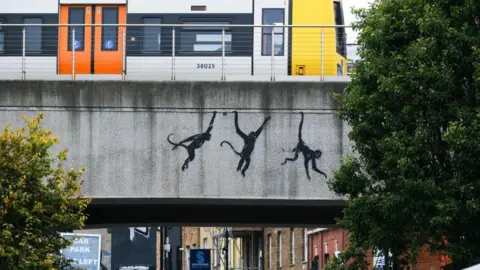 Getty Images
Getty Images
What do monkeys, wolves, pelicans, goats and elephants have in common?
We’re not at a zoo – these are all animals that Banksy has painted around London this week.
Each day, the elusive street artist has unveiled a new artwork in a different location in the capital, posting it on Instagram at 13:00 BST.
Banksy, famous for his enigmatic, often powerful artworks, has chosen not to caption his animals online.
He also hasn’t explained why they’re all painted in the same black stencil style.
All his agent would tell the BBC was that there was “no comment on the theme”, adding there “may or may not” be more animal paintings to follow.
This has left people to speculate about their meaning.

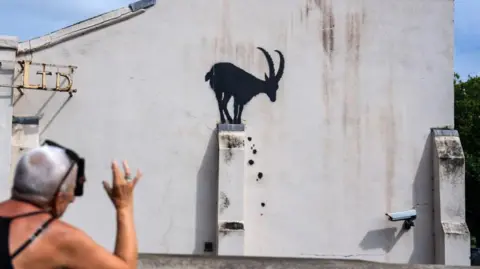 Getty Images
Getty Images
James Peak, presenter of the BBC’s The Banksy Story, thinks the message behind the paintings is less obvious than some of his previous works.
“It’s interesting that the meaning is more hidden than usual,” he tells the BBC.
“There’s often a message that is more clear and immediate in his work: maybe this time around he wants us to work it out for ourselves?”
Peak adds that Banksy’s animals show his trademark use of negative space, saying he’s “using the built environment as part of the art”, for “maximum impact from minimum effort”.
Peak also explains that the silhouettes for most of the animals this week are plain black, “with no adornments or shading”.
“The monkeys look like they’re swinging from the bridge,” he notes, “the pelicans are nicking the fish from the fish shop.”

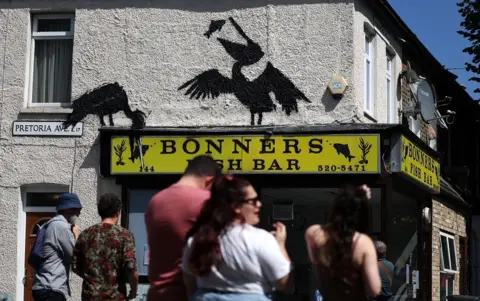 EPA-EFE/REX/Shutterstock
EPA-EFE/REX/Shutterstock
Banksy’s work is often political.
During Glastonbury, he set out a blow-up boat, filled with dummies in lifejackets, during a set from Bristol-based post-punk band Idles. It was controversial and the then Conservative home secretary James Cleverly called it “vile”.
Bansky responded, saying: “The real boat I fund, the MV Louise Michel rescued 17 unaccompanied children from the central Med last night. As punishment the Italian authorities have detained it – which seems vile and unacceptable to me.”
But he’s kept silent this time around.
Riots or environmental message?
Fan theories online have ranged from the goat being about the Israel-Gaza war to the animals being compared to far-right rioters across the UK.
Peak also highlights “other theories that all the animals are maybe threatened or near extinction”.
“The monkeys may be escaping gentrification and further development in the Brick Lane area. The elephants may be isolated and lonely,” he said.
The goat could represent Palestinians losing their footing – or may suggest “we may be distracted or preoccupied with the ‘Greatest of All Time’ and the Olympics – instead of big global issues”.


But what do people on the street think?
At 08:00 BST on Friday, Brick Lane is relatively quiet – the hum of tourists who usually descend for food, fashion and street art are nowhere to be seen yet.
But there are a few who take advantage of the lack of traffic, stopping in the middle of the street to take selfies and photos.
The three primates on a railway line have been associated with the three wise monkeys in the Japanese proverb – “see no evil, hear no evil, speak no evil”.
But in Banksy’s work, the monkeys are not covering their eyes, ears or mouths.
A group of women are excited to see the artwork, and a passerby stops and offers to take their photo together.
They tell the BBC they love Banksy because of the mystery surrounding his identity (Banksy’s identity has always remained a secret, though on The Banksy Story, a 2003 interview was unearthed, where the artist confirmed his name was Robbie).
“I love his work because it’s secret, it’s undercover, and it’s always topical – it’s not random,” Caz says.
“I think it might be in relation to what’s going on in the country at the moment,” says Sally, “a statement.”
About five minutes later, another man stops to take a photo on a professional camera – he says he’s going on a tour of London to catch the artworks which have appeared so far.

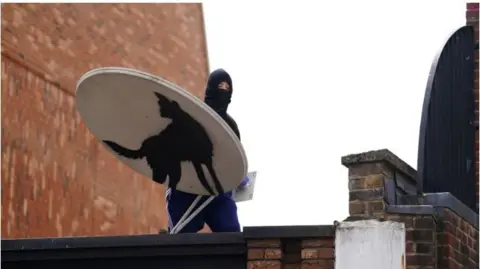 PA
PA
A couple of hours later, and it’s slightly busier in Walthamstow, where the fifth Banksy turned up on Friday: two pelicans eating fish, on the side of a chip shop.
It wasn’t officially announced on social media until 13:00, but the suspected work had been circulating online.
When I arrived there was a small huddle of people, mainly TV reporters and excited locals who were asking each other if the work is real.
“It brings character to the area – I’ve never seen people standing like this before,” says Hather Ali, one of the people who asked if it was a legitimate Banksy.
He lives next door to the fish shop and says he is going to check his CCTV footage from the night before, to see if he can see the secretive artist in action.
On Monday, following the first work in Richmond, media outlets published pictures of two men in a cherry picker – a mechanical platform at the end of a hydraulic lifting system.
One, who was masked, is believed to be Banksy.
Marcia McKnight has been living on the street for two decades and can see the artwork from her house.

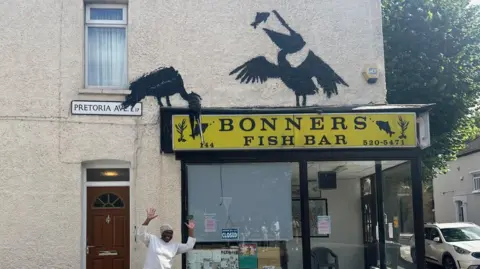
“I’m in heaven, this is fantastic for my street, for the local neighbourhood,” she says, adding it’s “amazing” for the family-run chippy.
“I’ve lived here 20 years, so I’ve seen the regeneration [of Walthamstow] happening.
“So it’s actually nice that we’ve got a piece of art, rather than a tower block or block of flats going up,” she adds.
Marcia thinks the artwork comes on the back of the anti-racism gathering in Walthamstow on Wednesday – thousands of people took to the streets chanting, clapping and preaching a message of peace.
“I would suspect [that’s what it’s about], as Walthamstow had one of the biggest anti far-right rallies.”
Although many people think the work is related to the UK riots, Peak still thinks it may have an environmental message.
Throughout his career, Banksy has created work centred around the environment – in 2002, he did a poster for Greenpeace featuring characters from The Jungle Book.
In 2003, he was responsible for a grim reaper, which was painted on the side of Thekla, a boat and nightclub venue in Bristol.
Or, says Peak, the latest artworks could be more straightforward than all the theories.
“It may be simply that he loves drawing animals and he’s having a great brat summer in London, proving he can still pop up and deliver something that gets the world talking, before he disappears again into the night.”








